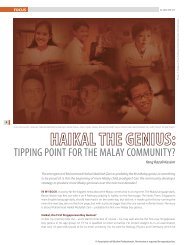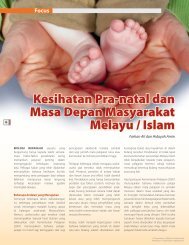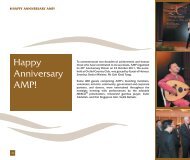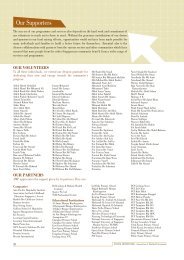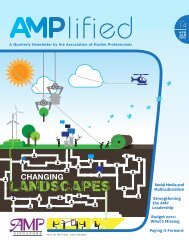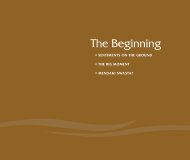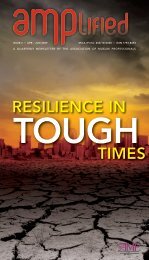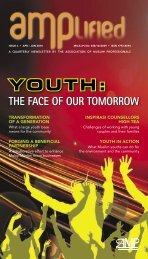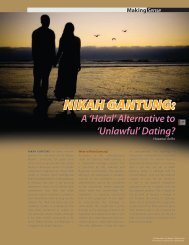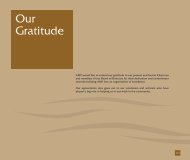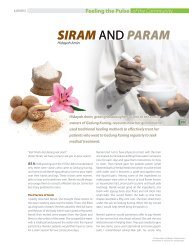The AMLA Amendments Overview - Association of Muslim ...
The AMLA Amendments Overview - Association of Muslim ...
The AMLA Amendments Overview - Association of Muslim ...
You also want an ePaper? Increase the reach of your titles
YUMPU automatically turns print PDFs into web optimized ePapers that Google loves.
KARYAWAN<strong>The</strong> <strong>AMLA</strong> <strong>Amendments</strong> <strong>Overview</strong><strong>AMLA</strong>, Mosques andMadrasahs inContemporary SingaporeSyed Muhd KhairudinAljuniedIF THE purpose <strong>of</strong> laws is to ensure thatjustice is upheld, it follows then that the raisond’être and function <strong>of</strong> the Administration<strong>of</strong> <strong>Muslim</strong> Law Act (<strong>AMLA</strong>) should be tosafeguard the interests and welfare <strong>of</strong><strong>Muslim</strong>s in Singapore. <strong>AMLA</strong> owes its origin toAhmad bin Mohammed Ibrahim, Singapore’sfirst State Advocate-General. Spurred by theseemed bleak. More than a mere document,the promulgation <strong>of</strong> <strong>AMLA</strong> in 1966 wasseen as imperative in the creation <strong>of</strong> a newSingaporean identity and a nation <strong>of</strong> equals.This article takes as its point <strong>of</strong> departurethe initial spirit <strong>of</strong> <strong>AMLA</strong>, setting it againstthe recent proposed changes. I argue thatA sense <strong>of</strong> inclusion, participation, and citizenship amongmembers <strong>of</strong> the public would help fend <strong>of</strong>f any tendency towardsalienation. As it stands, there is a pervasive ignorance amongthe members <strong>of</strong> the <strong>Muslim</strong> public with regard to the genesis,evolution and contents <strong>of</strong> the <strong>AMLA</strong>. This situation should not beleft unaddressed.11desire to preserve the religious life <strong>of</strong> <strong>Muslim</strong>sand troubled by the demands <strong>of</strong> a segmentwithin the minority community for a system<strong>of</strong> laws that would be over and above thesecular laws <strong>of</strong> Singapore, he saw <strong>AMLA</strong> asa mediating bridge between the state and acommunity <strong>of</strong> believers who constituted 15per cent <strong>of</strong> the total population.Although he believed that <strong>AMLA</strong> shouldbe continuously amended to keep up withthe changing conditions <strong>of</strong> society andthe demands <strong>of</strong> a maturing nation, AhmadIbrahim also held that any changes madeto the document should not result in unduehardship or an unwarranted burden uponthe <strong>Muslim</strong>s in Singapore. Such was theconcern <strong>of</strong> <strong>Muslim</strong> leaders and activists,at a time when the island-state had barelyrecovered from the trauma <strong>of</strong> separationfrom Malaysia in August 1965. <strong>The</strong> futurethat lay ahead <strong>of</strong> a country without its ownhinterland and lacking in natural resourcesthe recommendations to raise the minimum<strong>Muslim</strong> marriage age from 16 to 18, and totreat Syariah Court orders as District Courtorders for the purposes <strong>of</strong> enforcement,are appropriate given the prevalence<strong>of</strong> social problems arising from divorceand dysfunctional families. However, thebroadening <strong>of</strong> the Mosque Building andMendaki Fund (MBMF) to support mosqueupgrading and religious education may proveto be premature, or at best, a departure fromthe general spirit <strong>of</strong> <strong>AMLA</strong>.My observations are based on the speech <strong>of</strong>Dr Yaacob Ibrahim, the Minister-in-charge <strong>of</strong><strong>Muslim</strong> Affairs on 10th October 2008 at theIstana. I have also studied newspaper reportsand commentaries written by local scholarsand members <strong>of</strong> the general public, as wellas the <strong>AMLA</strong> itself, the Singapore Constitutionand other relevant governmental documents.What follows are some tentative ideas andcomments by a concerned <strong>Muslim</strong> Singaporean© <strong>Association</strong> <strong>of</strong> <strong>Muslim</strong> Pr<strong>of</strong>essionalsPermission is required for reproduction.
12<strong>The</strong> <strong>AMLA</strong> <strong>Amendments</strong> <strong>Overview</strong>Syed Muhd Khairudin Aljunied– comments which I hope the <strong>Association</strong> <strong>of</strong><strong>Muslim</strong> Pr<strong>of</strong>essionals (AMP) and other civicbodies can follow up on with further researchleading to recommendations for the seriousconsideration <strong>of</strong> those in authority.On MosquesIt would be foolhardy for a <strong>Muslim</strong> to rejectany proposal, whether it be from the secularstate or from non-state organisations, toupgrade the functions <strong>of</strong> the mosques. Asthey are places <strong>of</strong> worship and sites whichcontinuously preserve the Islamic identity, it isour collective responsibility to ensure that ourmosques are well-maintained and conducivefor worship by all <strong>Muslim</strong>s. It is through thearchitectural splendour and the sense <strong>of</strong>fellowship and serenity found within ourmosques that non-<strong>Muslim</strong>s can also appreciatethe Islamic way <strong>of</strong> life and God’s teachings.<strong>Muslim</strong>s in Singapore are certainly fortunateto have an institutionalised system whichchannels their funds towards the support<strong>of</strong> their houses <strong>of</strong> worship. Not only has thissystem assisted us in living up to the demands<strong>of</strong> the sacred, but they have also helped uswith our worldly needs as well. That said,concerns have been raised about the timing<strong>of</strong> the raising <strong>of</strong> the MBMF contribution by adollar or more.We are now in the midst <strong>of</strong> a global economicrecession; it is common knowledge that 80percent <strong>of</strong> <strong>Muslim</strong> contributors to the MBMFare making ends meet on monthly incomes<strong>of</strong> $3,000 or less. While there has been somePHOTO: AMPupward mobility in occupational pr<strong>of</strong>ile,less than 30 percent <strong>of</strong> Malays are holdingadministrative and managerial, pr<strong>of</strong>essional,and technical related jobs. <strong>The</strong>re is little doubtthat the remaining 70 percent will be severelyaffected by the looming downturn.This, along with other problems related tothe rising prices <strong>of</strong> basic necessities, pointsto one logical conclusion – that the increasein the amount <strong>of</strong> contributions to the MBMFought to have been postponed to a laterdate, at a time when issues <strong>of</strong> inflation andunemployment have been addressed. A wayaround this problem would be to build aMBMF: NEW CONTRIBUTION RATESTotal amount <strong>of</strong> employee’swages for the calendar monthmore effective mechanism that could allowfor a proper distribution <strong>of</strong> resources withinthe community.One possibility is resource-sharing amongstmosques. <strong>The</strong>re are 69 mosques, some withlarger monetary reserves than others due tovarious factors, such as the demography <strong>of</strong>the <strong>Muslim</strong> population in the areas wherethe mosques are located. All mosques obtainmost <strong>of</strong> their income from public donations,while some have engaged in pr<strong>of</strong>it-makinginvestments. Would it not be expedient formonetary and other resources from mosquesthat are better endowed to be channelled toothers that are in the process <strong>of</strong> upgrading,on a win-win basis? Could surplus fundsfrom the mosques also be channelled to themadrasahs on the same principle?<strong>The</strong> Islamic Religious Council <strong>of</strong> Singapore(MUIS) has full control over most mosquesin Singapore as provided for by <strong>AMLA</strong> point74.(1). Given this fact, I believe that MUIScould construct a system <strong>of</strong> mutual assistancebetween mosques which might help solve ourmonetary woes, at least in the next few years.In the long run, new programmes within themosques have to be devised to ensure thatthese institutions could generate their ownincome and depend less on donations.But the MBMF contribution would inevitablyhave to be increased eventually, even withstrong resistance from the community and/orat the risk <strong>of</strong> placing an added financial strainupon the low income earners as well as <strong>Muslim</strong>swith large families. Dr Yaacob has mentionedthat 80 percent <strong>of</strong> the <strong>Muslim</strong> communitywho are earning under $3000 will only pay anadditional dollar or less. For a clearer picture <strong>of</strong>his suggestion, the current contributions aredepicted in the table below.Amount <strong>of</strong> contributionspayable for the calendar month(1) Less than $1,001 $2(2) $1,001 or more but less than $2,001 $3(3) $2,001 or more but less than $3,001 $4(4) $3,001 or more but less than $4,001 $8.50(5) $4,001 or more $11KARYAWANContributions to the Mosque Buildingand Mendaki FundAn increase <strong>of</strong> $1 or less per month mayseem like a meagre amount for workingpr<strong>of</strong>essionals but may not be so for thoseearning very low incomes. I would like tocounter-propose that a new scale be addedfor those earning $4,000 and beyond. It isstated above that those earning $4001 andabove will have to contribute $11 a month.Raising the amount for those earning highsalaries to require them to contribute moreto the community is a viable option. Nodefinite figures should be proposed untilthere has been further research into thismatter, and a public discussion on this issueis more than wanting.More immediately, in the midst <strong>of</strong> animpending economic crisis and a likelyincrease in unemployment, it will behelpful, if not a morale booster, for ministers,Members <strong>of</strong> Parliament (MPs) and otherswho earn high salaries to shoulder ‘the onedollar or less’ monthly raise in the MBMF. <strong>The</strong>ycan “adopt” groups <strong>of</strong> <strong>Muslim</strong>s within thelower-income bracket who may experience© <strong>Association</strong> <strong>of</strong> <strong>Muslim</strong> Pr<strong>of</strong>essionalsPermission is required for reproduction.
KARYAWAN<strong>The</strong> <strong>AMLA</strong> <strong>Amendments</strong> <strong>Overview</strong>‘<strong>The</strong> latest changes to <strong>AMLA</strong> could lead to disappointment ifpublic funds were disbursed only to those madrasahs that are inthe JMS and not to others that chose to opt out.’problems in paying the added amount tothe MBMF. Is this workable for the next fewyears to come? Are we ready to reconsiderour policies by looking at them through theeyes <strong>of</strong> the poor and the needy?On MadrasahsIt is clear that the Islamic religiouseducational system in Singapore needs tobe boosted in terms <strong>of</strong> new capacities andcapabilities. Over the years, many books,academic articles and opinion pieceshave been devoted to addressing thecircumstances that led to the stagnation<strong>of</strong> the madrasahs in historical Singaporeand at present. This has culminated inthe introduction <strong>of</strong> the Joint MadrasahSystem (JMS), to be implemented in 2009,whereby three madrasahs out <strong>of</strong> the sixhave chosen to opt out. On the one hand,the JMS is welcomed by a cross-section<strong>of</strong> the <strong>Muslim</strong> community as a stimulusfor the establishment <strong>of</strong> model Islamicschools. On the other, the latest changesto <strong>AMLA</strong> could lead to disappointment ifpublic funds were disbursed only to thosemadrasahs that are in the JMS and not toothers that chose to opt out. It is thereforea right move that the non-JMS madrasahswill eventually also be benefiting from theexpanded MBMF.<strong>The</strong> three madrasahs that opted out <strong>of</strong>the JMS system have been survivingwith minimal governmental funding, andhave been reliant upon private trusts anddonations since their founding. MadrasahAlsag<strong>of</strong>f imposes the lowest fees incomparison to the other six madrasahs.Madrasah Al Maarif and more recentlyMadrasah Wak Tanjong have produced finegraduates <strong>of</strong> local and overseas universities.Madrasah Alsag<strong>of</strong>f students are known tobe excellent graduates <strong>of</strong> Islamic universitiesin Malaysia and overseas. <strong>The</strong> level <strong>of</strong>competency in the Arabic language amongits students is said to be the highest.Two out <strong>of</strong> the three madrasahs havemet the basic requirements <strong>of</strong> achievingthe targeted Primary School LeavingExamination (PSLE) score for them in 2008.<strong>The</strong>re are, <strong>of</strong> course, exceptions to thesesuccess stories, and the same could be saidabout students in the national schools. If thethree non-JMS madrasahs are excluded fromthe MBMF scheme, it would more likely tolead to a hardening <strong>of</strong> their present stance<strong>of</strong> staying out <strong>of</strong> the JMS.Seen in this light, I propose that the MBMFfunds meant for madrasah education bedistributed equally amongst all madrasahs,and that efforts be made to gain thecooperation <strong>of</strong> those that have not embracedthe JMS scheme. As for the JMS madrasahs,the onus is upon them and MUIS to ensurethat they provide high standards <strong>of</strong> religiouseducation so as to be fine exemplars for thenon-JMS madrasahs in Singapore and als<strong>of</strong>or religious schools regionally and globally.Some Implications<strong>The</strong> debates surrounding <strong>AMLA</strong> and itslatest amendments have two other, widerimplications. First, surveys, if they are notalready done, should be conducted on theperceptions, views and attitudes <strong>of</strong> <strong>Muslim</strong>sin Singapore about <strong>AMLA</strong>, the recentamendments and the ways in which fundsshould be disbursed. By doing so, we canavoid the mistake <strong>of</strong> basing our discussions,arguments and decisions with regard to<strong>AMLA</strong> upon anecdotal evidence or uponthe voices <strong>of</strong> a select few. Secondly, thecontents <strong>of</strong> <strong>AMLA</strong> should be communicatedto the <strong>Muslim</strong> public. This could be takenup by the Centre for Research on Islamicand Malay Affairs (RIMA) with the assistanceand expertise to be gained from practisinglawyers and concerned academics.Although <strong>AMLA</strong> has now been madeavailable online, there is an urgentneed to provide clear explanations oneach <strong>of</strong> the <strong>AMLA</strong> provisions, includingthe embedded benefits and possibleimplications. <strong>Muslim</strong>s in Singapore willbenefit greatly from the knowledge <strong>of</strong>a law that serves to protect their rightsand ensure their welfare. This wouldalso help them be more aware <strong>of</strong> theroles and responsibilities <strong>of</strong> both thegovernment and the leaders <strong>of</strong> the<strong>Muslim</strong> community.A sense <strong>of</strong> inclusion, participation, andcitizenship among members <strong>of</strong> thepublic would help fend <strong>of</strong>f any tendencytowards alienation. As it stands, there is apervasive ignorance among the members<strong>of</strong> the <strong>Muslim</strong> public with regard to thegenesis, evolution and contents <strong>of</strong> the<strong>AMLA</strong>. This situation should not be leftunaddressed.Syed Muhd Khairudin Aljunied is Assistant Pr<strong>of</strong>essor at the Malay Studies Department,National University <strong>of</strong> Singapore (NUS). His views are personal and do not reflect theposition <strong>of</strong> the department or NUS.13© <strong>Association</strong> <strong>of</strong> <strong>Muslim</strong> Pr<strong>of</strong>essionalsPermission is required for reproduction.



